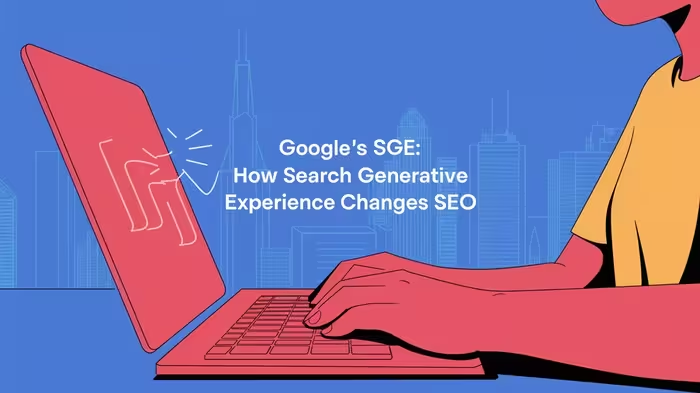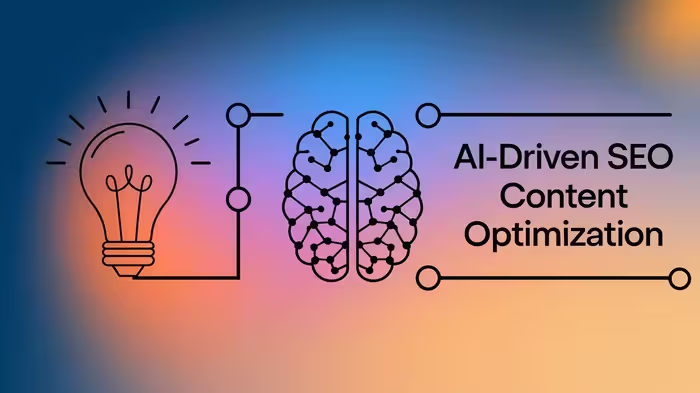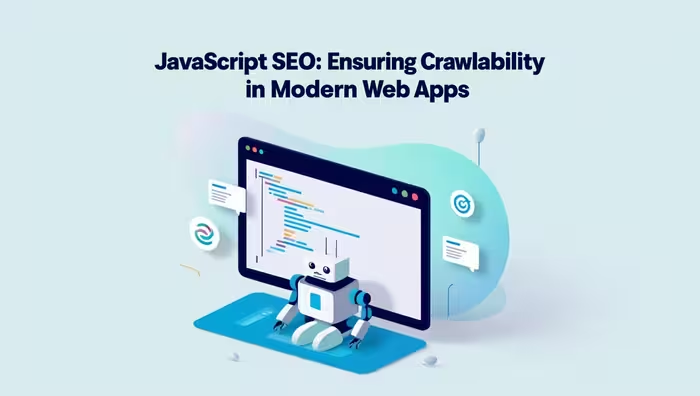In the ever-evolving world of search engine optimization (SEO), a seismic shift is on the horizon. Google’s Search Generative Experience (SGE) is poised to revolutionize how we find information online and, consequently, how we approach SEO.
As digital marketers, we’re standing on the brink of a new era in search technology. Are you ready to dive into this brave new world? Let’s explore how SGE is reshaping the landscape of search and what it means for your SEO strategy.
Understanding Google’s Search Generative Experience (SGE)
What is SGE?
Imagine a search engine that doesn’t just find information but creates it. That’s the essence of Google’s Search Generative Experience.
SGE is like having a super-smart assistant that not only sifts through the internet’s vast library but also synthesizes the information to give you a tailored response. It’s Google’s answer to the growing demand for more intuitive, conversational search experiences.
How SGE Works
At its core, SGE is designed to understand and respond to queries in a more human-like manner. When you type in a question, instead of just presenting a list of links, SGE generates a comprehensive answer drawing from multiple sources.
It’s like having a knowledgeable friend who can quickly summarize complex topics for you. The key difference? This friend has access to the entirety of the internet’s knowledge.
The AI Behind SGE
Powering SGE is a sophisticated AI model trained on vast amounts of data. This isn’t your run-of-the-mill algorithm; it’s a learning system that continuously improves its understanding of language, context, and user intent.
Think of it as a digital polymath, capable of making connections and drawing insights across a wide range of topics.
The Impact of SGE on Traditional Search Results
Changes in SERP Layout
With SGE, the search engine results page (SERP) as we know it is getting a makeover. Traditional organic listings are being pushed down to make room for the AI-generated content at the top.
It’s like the front page of a newspaper being rewritten in real-time for every reader. This shift means that ranking first may no longer guarantee the visibility it once did.
Shift in User Behavior
As users become accustomed to receiving instant, tailored answers, their search behavior is likely to change.
Why click through multiple links when you can get a comprehensive answer right at the top? This shift is akin to how smartphones changed the way we consume information – instant gratification is becoming the norm in search as well.
The Fate of Featured Snippets
Featured snippets, once the crown jewels of search results, are facing an uncertain future. SGE has the potential to replace or augment these snippets with more dynamic, context-aware content.
It’s like upgrading from a static billboard to a interactive digital display – the information becomes more engaging and adaptable to the user’s needs.
SEO Strategies for the SGE Era
Content Optimization for AI Consumption
In the age of SGE, we’re not just writing for humans anymore – we’re writing for AI, too. This doesn’t mean stuffing your content with keywords.
Instead, focus on creating clear, well-structured content that AI can easily parse and understand. Think of it as teaching a class where one of your students is an extremely intelligent robot – you want to be clear, logical, and comprehensive.
Enhancing E-E-A-T Signals
Experience, Expertise, Authoritativeness, and Trustworthiness (E-E-A-T) are more crucial than ever. SGE is likely to prioritize content from sources it deems credible.
Building your brand’s authority is like establishing yourself as a respected professor in your field – the more credible you are, the more likely SGE is to reference your work.
Leveraging Structured Data
Schema Markup for SGE
Structured data helps SGE understand the context and relationships within your content. Implementing schema markup is like providing SGE with a detailed map of your website’s content.
It helps the AI navigate and understand your information more effectively.
Data Highlighter Tools
Use Google’s Data Highlighter and other structured data tools to make your content more SGE-friendly.
It’s like tagging your content with bright, easy-to-read labels that catch SGE’s attention and help it categorize your information accurately.
Adapting Keyword Strategy for SGE
Long-Tail Keywords and Natural Language
With SGE’s ability to understand natural language, long-tail keywords and conversational phrases become more important.
It’s like optimizing for a conversation rather than a catalog search. Focus on how people actually ask questions, not just on individual keywords.
Intent-Focused Keyword Research
Understanding user intent is crucial in the SGE era. It’s not just about what users are searching for, but why they’re searching for it.
Think of it as being a mind reader – the better you can anticipate and address the underlying needs of your audience, the more likely SGE is to favor your content.
Semantic SEO in the Age of SGE
Semantic SEO focuses on the meaning behind words rather than the words themselves. In the context of SGE, this means creating content that covers topics comprehensively and addresses related concepts.
It’s like weaving a rich tapestry of information rather than painting with broad strokes.
Content Creation in the SGE Landscape
Comprehensive, In-Depth Content
SGE thrives on content that provides thorough, nuanced information. Gone are the days of thin content designed to target specific keywords.
Instead, create in-depth pieces that cover all aspects of a topic. It’s like writing a definitive guide rather than a brief overview – give SGE plenty of high-quality information to work with.
Multimedia Integration
Incorporate various media types into your content. SGE is capable of understanding and synthesizing information from images, videos, and infographics.
Think of your content as a multimedia presentation – the more diverse and engaging your content, the more likely SGE is to find it valuable.
User Experience and Engagement Metrics
User experience and engagement metrics are likely to play a significant role in SGE’s evaluation of content quality. Focus on creating content that not only informs but also engages your audience.
It’s like hosting an interactive workshop rather than giving a lecture – the more your audience engages with your content, the more valuable SGE will consider it.
Measuring SEO Success with SGE
New KPIs for SGE Optimization
Traditional SEO metrics may not fully capture success in the SGE era. We need to develop new key performance indicators (KPIs) that reflect visibility and engagement within SGE-generated results.
It’s like updating our navigational tools for a new terrain – we need metrics that accurately measure our progress in this new landscape.
Tools for SGE Performance Tracking
As SGE rolls out, new tools and features in existing SEO platforms will emerge to help track performance. Stay on top of these developments and be ready to adapt your tracking methods.
It’s like upgrading your toolkit – make sure you have the right instruments to measure your success in the SGE ecosystem.
Adapting Reporting for Stakeholders
Educate your clients or stakeholders about the changes brought by SGE and how it affects traditional SEO metrics. Be prepared to explain new concepts and potentially redefine what success looks like in search.
It’s like being a translator between the old world of SEO and the new – help your stakeholders understand and navigate this transition.
Conclusion
The advent of Google’s Search Generative Experience marks a new chapter in the story of search. As SEO professionals, we’re not just witnesses to this change – we’re active participants in shaping how it unfolds.
By understanding SGE, adapting our strategies, and staying agile in our approach, we can turn this challenge into an opportunity.
Remember, the core principles of creating valuable, user-focused content remain as important as ever. As we navigate this new landscape, let’s embrace the change and continue to evolve our craft. The future of search is here, and it’s generative – are you ready to generate success in this new era?
Frequently Asked Questions
- Will SGE completely replace traditional search results?
While SGE is a significant change, it’s unlikely to completely replace traditional results in the near future. Instead, expect a hybrid SERP where SGE-generated content coexists with traditional organic listings. - How can small businesses compete in the SGE landscape?
Focus on creating high-quality, niche content that demonstrates expertise in your specific area. SGE values authoritative content, regardless of the size of the business behind it. - Does SGE mean the end of link building as an SEO strategy?
Not at all. While the impact of links may evolve, they remain a crucial factor in establishing authority and relevance. However, the focus should shift towards earning high-quality, relevant links rather than sheer quantity. - How often will SGE-generated content be updated?
Google hasn’t provided specific details, but given the nature of AI and machine learning, it’s likely that SGE content will be updated frequently to reflect the latest information and user behaviors. - Can we optimize directly for SGE, or should we focus on traditional SEO practices?
While some SGE-specific optimization strategies are emerging, many traditional SEO best practices remain relevant. Focus on creating high-quality, user-focused content while staying informed about SGE developments and adapting as needed.


